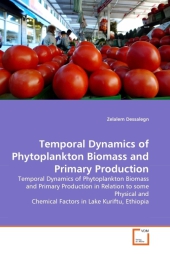 Neuerscheinungen 2011Stand: 2020-01-07 |
Schnellsuche
ISBN/Stichwort/Autor
|
Herderstraße 10
10625 Berlin
Tel.: 030 315 714 16
Fax 030 315 714 14
info@buchspektrum.de |

Zelalem Dessalegn
Temporal Dynamics of Phytoplankton Biomass and Primary Production
Temporal Dynamics of Phytoplankton Biomass and Primary Production in Relation to some Physical and Chemical Factors in Lake Kuriftu, Ethiopia
2011. 96 p.
Verlag/Jahr: VDM VERLAG DR. MÜLLER 2011
ISBN: 3-639-36720-0 (3639367200)
Neue ISBN: 978-3-639-36720-1 (9783639367201)
Preis und Lieferzeit: Bitte klicken
In a world of ever increasing human population where food production is not meeting demands, study of productivity at all levels of the food chain becomes essential. In order to meet the growing food requirements of the world population great effort is necessary in the development and utilization of the biological wealth of the aquatic environment. It is from this point of view that the study of aquatic productivity at the beginning of food chain becomes a logical starting point. Research on aquatic, as on terrestrial ecosystems, is increasing in intensity. Aquatic ecosystems have received attention as actual and potential sources of food. The exploitation of aquatic resources for human food involves a wide range of studies.Lake Kuriftu is a shallow, frequently mixing, moderately turbid and productive lake. The lake exhibits temporal variations in photosynthetic biomass and production of phytoplankton. These variations seem to be related to hydrological and hydrographic conditions of the lake, which in their turn determine the levels of nutrients and their spatial variations as Talling (1992) has pointed that the temporal changes in biological parameters of lakes.
The availability and sustainable use of natural resources determines the food security situation of a country. Lakes are one of humanity´s most important resources.Biomass and Photosynthetic productivity of phytoplankton in relation to the physical and chemical conditions of the water column in lake determines the productivity of the lake.


